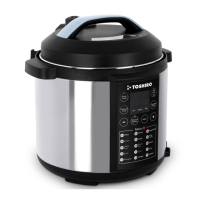Food volume
For fresh ingredients such as meat and vegetables, never exceed the MAX mark
on the inside of the bowl.
For rice, dry beans, dried vegetables, pulses and grains, never exceed 50% of the
bowl capacity with total volume of food and liquid as these foods will expand when
cooking and could block the safety valves.
Preparation guidelines
This section includes some guidelines to get you started with pressure cooking of
basic food types. Use these guidelines to begin cooking with your-cooker and
update your recipes as you learn to cook to your preference.
Always check that food is fully cooked before serving it.
Browse the Internet for many more pressure cooking recipes and ideas.
Preparing meat
Meat will generally cook best if it is first browned in a little oil in a pan on the
stove. Whole cuts can be cooked or meat can be cooked or meat can be cubed
pieces, but cooking times should be adjusted accordingly. Add approximately
250ml water or stock in the pan if cooking for less than 45 minutes. For longer
cooking times, add 375ml.
Preparing fresh vegetables
Prepare vegetables as you would when cooking them in a regular pan on the
stove. Wash and peel them, then cut into equal size pieces to cook uniformly. Add
approximately 120ml water or stock to the pan with the vegetables.
Preparing long grain or basmati rice
Measure the rice into a bowl and rinse it first in a few changes of water. 160ml of
dry rice is approximately one portion. Add approximately 240ml water per 160ml
measure to the bowl and 15-20ml oil to reduce foaming.
Preparing brown rice
Follow the previous instruction for white rice, but add 50% more water.
Dried beans, pulses etc
Pick over the beans and discard any stones or debris. Place the beans into a bowl
and rinse in a few changes of water. Place the beans in the cooking bowl with
onions, garlic, herbs etc to taste.Add water in the ratio of approximately 1500ml to
500g beans and 30-50 ml oil to reduce foaming.
BEFORE YOU START
9

